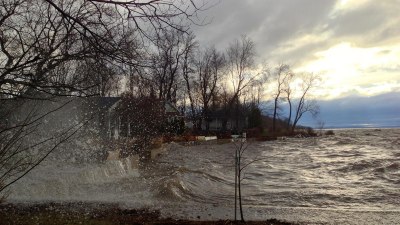Why Some Rivers Flood More Than Others
Discover the factors that influence river flooding patterns and understand the science behind varied flood risks.

Flooding is a natural phenomenon that can have devastating impacts on communities, economies, and ecosystems. Understanding why some rivers flood more than others is essential for managing risks and preparing for potential disasters. Various factors contribute to the flood risk of a given river, including geographical, climatic, and human-related elements. In this article, we will explore these aspects in detail, providing insights into the complexity of river flooding.
1. Topography and Geography
The physical landscape through which a river flows plays a critical role in its flooding behavior. Steep valleys may cause rivers to rise quickly in response to rainfall, resulting in flash floods, whereas rivers flowing through flat plains often experience slower, more controlled flooding. Floodplains are regions adjacent to rivers that can be prone to inundation, and their extent varies dramatically between different river systems. For example, the Mississippi River, with its broad floodplains, can handle large volumes of water but can also spread flooding over vast areas, affecting more communities.
2. Rainfall Patterns
Precipitation is a primary driver of river flooding. Areas that experience heavy rainfall in short periods are more likely to see rivers flood than regions with gradual rainfall. Intense storms, particularly those brought about by tropical systems or thunderstorms, can generate excess runoff that local rivers cannot accommodate, causing flooding. Additionally, the timing of rainfall is crucial; for instance, if rains occur following snowmelt, rivers may see a significant rise in water levels due to combined runoff from both precipitation and snowmelt.
3. Soil Types and Saturation
Soil characteristics significantly influence how much water can be absorbed before reaching saturation point. Clay soils tend to hold water longer and are less permeable than sandy soils, resulting in quicker runoff into rivers during heavy rains. In regions where the soil is already saturated due to previous rainfall, even a small amount of additional precipitation can lead to flooding. Understanding the soil composition in a river's watershed is essential for predicting flood risks.
4. River Channel Alterations
Human activities can drastically change the natural flow of rivers, directly impacting flooding. Dams, levees, and diversions can contain and manage water flow, but they can also fail, leading to catastrophic floods. Urbanization tends to increase impermeable surfaces like roads and buildings, which exacerbate runoff and can overwhelm drainage systems. Conversely, natural rivers exhibit different behaviors based on their morphology; meandering rivers can slow down and meander floodwaters, while straightened rivers may increase flood velocity.
5. Climate Change Impact
As global temperatures rise and climate patterns shift, the frequency and intensity of extreme weather events are increasing. This includes changes in precipitation patterns, with some areas experiencing heavier rainfall while others face drought. These fluctuations can lead to unprecedented flooding scenarios, even in regions traditionally considered safe from floods. Rising sea levels may also contribute to flooding in coastal river areas, further complicating flood risk scenarios.
6. Vegetation and Land Use
Forests, wetlands, and other forms of vegetation play a crucial role in regulating water flow and absorbing precipitation. Areas with abundant vegetation can slow down water flow and reduce flooding. Deforestation or urbanization that removes this natural cover can lead to increased runoff and higher flood risks. Additionally, land use practices, such as agriculture on floodplains, can also contribute to altered drainage patterns, potentially exacerbating flooding.
7. Historical Flooding Events
Understanding a river's history can provide valuable insights into its flooding patterns. Some rivers have established records of flood events that can help predict future risks. Historical data, including flood frequency and severity, can be instrumental in developing flood management strategies. Communities living in flood-prone areas can benefit from this historical knowledge to implement proactive measures, such as flood insurance or emergency plans.
8. Flood Management Strategies
Effective flood management is vital for reducing risks associated with river flooding. Strategies may include constructing levees and flood walls, creating retention basins, and restoring wetlands to absorb floodwaters. Additionally, early warning systems can alert communities to impending flood threats, allowing residents to evacuate or take other necessary precautions. Successful flood management also depends on collaboration among governments, local communities, and emergency responders.
9. Case Studies: Diverse River Flooding Examples
Examining specific river systems provides valuable insights into the diverse factors influencing flooding. For instance, the Nile River experiences seasonal flooding due to snowmelt from the Ethiopian Highlands, impacting agriculture in Egypt. In contrast, the Yangtze River in China has faced catastrophic floods due to a combination of intense rainfall, rapid industrialization, and deforestation, highlighting the interplay of environmental and anthropogenic factors. Each river's unique challenges necessitate tailored solutions for flood management.
10. The Future of River Flooding
As climate change progresses and urban areas expand, understanding and addressing river flooding will become increasingly critical. Innovations in technology, such as improved modeling and mapping techniques, can enhance flood prediction capabilities. It is essential to combine scientific knowledge with community action to foster resilience against flooding. Future urban planning must take into account floodplain management and sustainable practices to mitigate risks. Collaboration among governments, NGOs, and communities is crucial for building adaptive strategies to address these challenges. By understanding the diverse factors influencing river flooding, we can better prepare for the future and mitigate potential impacts on society and the environment.











